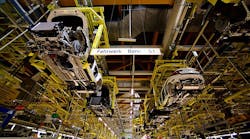Factories from America’s Rust Belt to Germany’s Ruhr region to Japan’s Aichi prefecture are revving up production lines in a unified acceleration not seen in years.
Global manufacturing indexes have forged ahead to multiyear highs, in concert with improving economies rich with the tinder of easy monetary policy. In the U.S., a resurgence in corporate investment is driving equipment orders. Germany, where business sentiment is near a record, is helping engineer a pickup in Europe’s economy.
Combined with solid manufacturing in Japan, a measure of activity among producers in developed nations has muscled ahead to the highest level in nearly seven years. The collective strength in the biggest industrial economies is more than offsetting a stabilization in production at China’s factories.
What Our Economists Say...
“With the global economy gradually heating up and threats of protectionist policies not yet translating into action, the manufacturing sector should remain on the upswing ... China, the world’s largest manufacturer, will pursue a politically driven slowdown to reduce leverage and overcapacity, as the country’s economy moves toward a new growth model, which will continue to weigh on manufacturing growth.”-- Michael McDonough, Bloomberg Economics
One benchmark of worldwide demand for raw materials is in a steady uptrend that began around midyear. The Baltic Dry Index, a measure of freight rates for shipping dry bulk commodities around the globe, recently hit its highest point since early 2014. As economic activity picks up, prices tend to follow along with demand for industrial materials.
In the U.S., there’s been a notable acceleration in orders and shipments of capital goods. Investment in equipment and software increased at a 10.4% annualized pace in the third quarter, the fastest in three years, according to the government’s calculation of gross domestic product.
Monthly figures show the strength is carrying into the fourth quarter. Sales of non-military capital goods excluding aircraft, a proxy for business investment in equipment, rose at a 14.7% annualized rate in the three months ended in October, the strongest since October 2011.
Amid percolating demand, American factories are operating at rates not seen in the last nine years. The share of production facilities in use climbed to 76.4% in November, according to the latest figures from the Federal Reserve. The figures help explain why plants are stepping up hiring.
It’s not just progress in the world’s largest economy that is fueling orders and shipments of capital goods. Global sales of machines from Caterpillar Inc., a producer of construction, mining and forestry equipment, were up 26% in November from a year ago -- the strongest advance since early 2012.
Across the Atlantic from the U.S., manufacturers are brimming with confidence. A measure of sentiment among factory managers in the euro area climbed to an all-time high last month, according to European Commission data going back to 1985.
While such “soft” data should be interpreted with caution because they reflect confidence rather than output, German factory orders are showing promise and indicate firmer production in coming months.
U.K. factories are stepping it up on the heels of the firmer tone in Europe’s economy. The Confederation of British Industry’s latest factory index held at 17 in December, matching the strongest reading since 1988. While the measure for export orders slowed this month, it was well above its long-term average and helped by a weaker pound.
The optimism that’s prevalent in the U.S. and Europe is stretching to Asia’s biggest developed economy, as factory managers in Japan grow more upbeat about their prospects. Officials at small factories in Japan haven’t been this optimistic about conditions in 16 years, underscoring solid growth momentum.
Combined with an upswing among large manufacturers, the Bank of Japan’s Tankan survey’s diffusion indexes highlight broad improvement.
Such confidence is being reflected in firmer orders and production. The value of the yen and elevated demand from trading partners are creating a solid base for bookings and output. Industrial production in Japan increased 5.9% in October from a year earlier, the second-largest 12-month gain since 2014. Foreign orders for machine tools are up on the same basis by the most since 2011.
By Vince Golle




